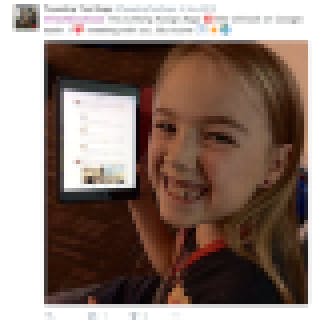It is quickly becoming a non-negotiable for all classrooms to leverage social media in order to communicate with families and other classrooms—thus engaging others in the daily lives of students. While simply posting “fun” photos is a start, this novelty wears off quickly, and as a result, we must think more critically about how we communicate via social media.
As a second grade teacher who facilitates a student-centered classroom, I now believe our use of social media is an opportunity for students to partake in the type of learning in which they can thrive and shout their story to the world.
1. Genuine Digital Citizenship Opportunities
In fall 2012, I liked the idea of Twitter, but the thought of social media infiltrating my classroom was still a bit scary. So I developed an analog Twitter bulletin board and had each student write out their tweets on sentence strips daily.
A month later, I realized the value of students sharing work with more than just those in our classroom. So, I jumped right in and set up a Twitter account under my name, with the intention of letting the students run it. However, rather than immediately giving them complete control, and possibly negatively affecting all of our digital footprints, we prepared ourselves through digital citizenship bootcamp. Throughout these lessons, we used gradual release of responsibility (the same technique used in my classroom in other subject areas) to systematically turn the “social media reins” over to the students.
At first, while this whole process was uncomfortable for me (to say the least), I understood I was doing my students a disservice by not actually helping them to develop their digital footprints in a genuine environment. In the end, my comfort level was less important than their experiences on social media.
What we do in my classroom: This fall, students in our classroom completed digital citizenship bootcamp. My students had to pass seven different digital citizenship rules before I was going to give them access to our accounts as “Tweeter of the Day” and “Instagrammer of the Day”. To take this a step further, I also had parents come in one night to complete the boot camp, as well. That’s right—a parent social media bootcamp, where my students were the teachers, helped their parents get set up with accounts, and taught them about everything from retweets to our district hashtags.
2. Publishing for the World (and the Classroom Across the Hall) is Powerful
When we allow students to write and share their work with the world, suddenly their work becomes more valuable. Students will always do their worst writing when they know the only person who will ultimately view it is their teacher. How many assignments in classrooms are completed solely for teacher as a requirement of the curriculum?
Additionally, while sharing our stories with the world is invaluable, there’s something to be said with simply using social media to share your story across the hallway. Canadian educator George Couros challenged me to use our account in a way that could connect our classroom with not only the world, but the other classrooms right in our school. This is where our school hashtag #LegacyK5 was born.
What we do in my classroom: Students in my classroom now post to that hashtag knowing our principal, previous teachers, future teachers, and other staff members are going to see their work. When my students tweet, blog, or post on our Instagram page, they are sharing their work with thousands of followers. There is a positive and almost competitive pressure in knowing that their work will be viewed by their parents, other classrooms around the world, friends, our principal, and experts—and best of all, they step up their game because they have an authentic audience to share their work with.
3. Establishing Your Classroom Brand
According to educators Joe Sanfelippo and Tony Sinanis, branding can be defined as “the marking practice of creating a name, symbol or design that identifies and differentiates a product from other products.” Within the past few years, this idea of branding our schools/classrooms has become extremely valuable, as it promotes transparency by painting an accurate, live picture of what is taking place. Yet, in reality, the majority of the time the educators are the ones telling these stories. While this certainly has its place, ultimately what matters most is how students feel about their experiences. Social media has allowed my students to share our classroom happenings through their eyes. It has allowed my students the opportunity to both establish and share the culture of our classroom and our school, and ultimately create our “brand”.

What we do in my classroom: By literally handing over classroom devices that are logged into our accounts, I am giving my students control to cultivate our brand. We have a rule in our classroom to only share pictures and the work of students that are engaged or making smart choices. Additionally, my students start each day with an introductory post (and usually a selfie or picture with me), and sign every post so our followers know who is writing that day. Day by day and month by month, they are sharing work that they deem important from inside our four walls.
The Sky’s the Limit
The opportunities my students have had because of Twitter far outweigh the risks associated with setting up a student lead account. In November, my students had the life-changing opportunity to do a Google Hangout with Brad Waid while he was doing professional development in Hong Kong, China. Following him on Twitter two years ago lead to this beautiful relationship that allows us to follow his journey all over the globe. He has brought new culture, knowledge, and expertise to our classroom. Brad has been an amazing expert who has connected with my classroom over and over again.
In January, my students were invited to do a Google Hangout to chat about digital citizenship with the #DigCitSummitUK. My students became global speakers overnight because of their outstanding work on our social media accounts. To say this is an honor would be an understatement—such a proud teacher moment!
Social media is happening—with or without you. The lessons my students learn by taking ownership of social media ends up enhancing all of their work, both in and out of school. And let’s be honest… wouldn’t you prefer to have your students write the story of your classroom, rather than someone else?


